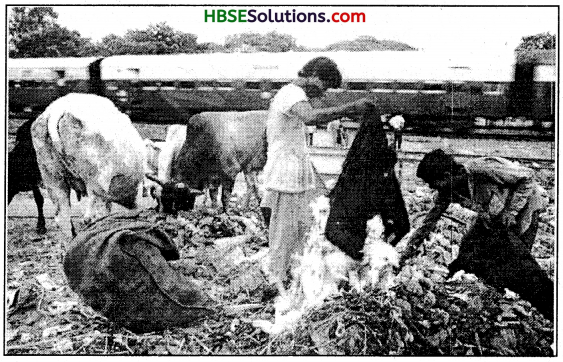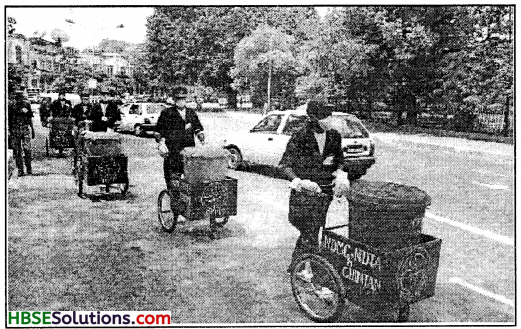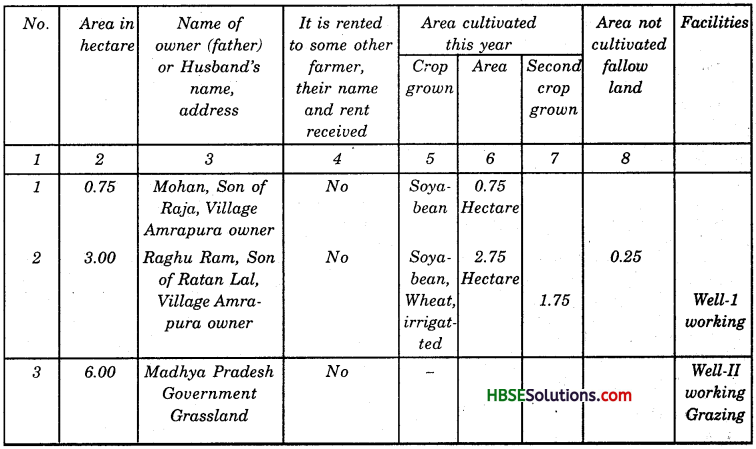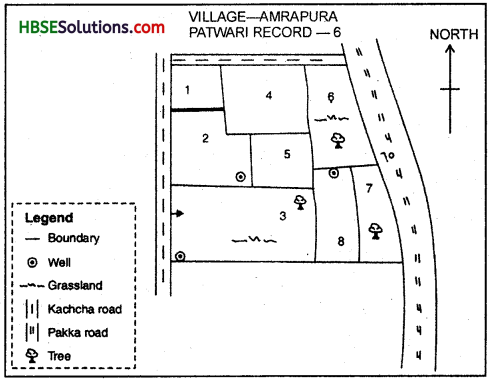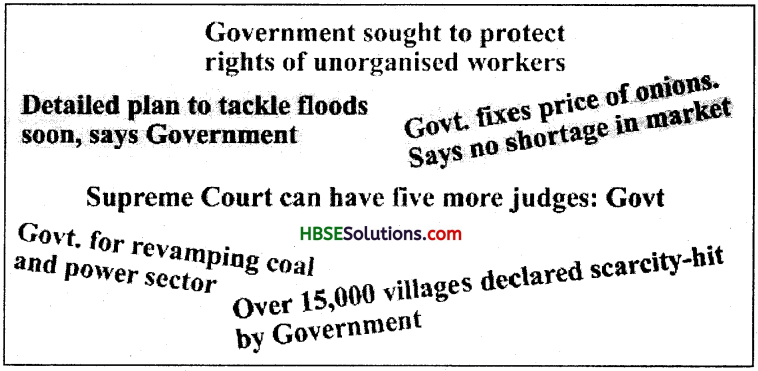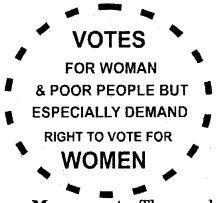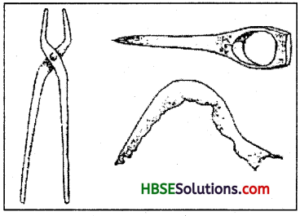Haryana State Board HBSE 6th Class Social Science Solutions Civics Chapter 8 Rural Livelihoods Textbook Exercise Questions and Answers.
Haryana Board 6th Class Social Science Solutions Civics Chapter 8 Rural Livelihoods
HBSE 6th Class Civics Rural Livelihoods Textbook Questions and Answers
Class 6 Civics Chapter 8 HBSE Rural Livelihoods Question 1.
Based on the above diagram would you say the Thulasi earns money throughout the year?
Answer:
No. Thulasi works in seasonal job which is agriculture she earns only during those seasons when she has work on her fields. According to the given data, it can be important that from June to December, she earns.
Class 6 Civics Chapter 8 Question Answer HBSE Question 2.
Describe the work that Thulasi does. How is it different from the work that Raman does?
Answer:
Thulasi transplants paddy in the fields. Thulasi’s husband, is also a labourer. They don’t own any land. While Thulsi transplants, Raman sprays pesticides.

Rural Livelihoods Class 6 Civics Chapter 8 Question Answer Question 3.
Thulasi gets paid very little money for the work. She does, why do you think agricultural labourers like her are forced to accept low wages.
Answer:
1. Agricultural labourers are unskilled and do not have the knowledge or access to higher paid jobs.
2. They are under the debt of landlords or moneylenders who employ them on low wages.
Question Answer Class 6 Civics Chapter 8 HBSE Rural Livelihoods Question 3.
In what ways would her way of earning a living have been different if Thulasi own some farm land? Discuss.
Answer:
1. If Thulasi would have owned a farm land she would have been the possessor of all the process.
2. She would have an increased income by selling all her-crop to the market.
3. This would have an impact on her livelihood.
Question 4.
What are the crops grown in your region or nearby rural are? What kinds of works do agricultural labourers do?
Answer:
Maize, Wheat and Rice is planted in the neighbourhood village.
Agricultural labourers do the following works:
(a) Ploughing fields
(b) Preparing saplings
(c) Transplanting saplings
(d) Irrigating crops
(e) Weeding
(f) Harvesting
(g) Storage of crops.
Question 5.
What work does Sekar’s family do. Why do you think Sekar does not usually employ labourers for doing farm work?
Answer:
Sekar’s family works in the field, harvests crop and does all sort of agricultural work.
Sekar might not be employing labourers for farm work to cut cost on manual labour. Money has to be given to labour for doing work.
Question 6.
Why does Sekar not go to the town market to get a better price for his paddy?
Answer:
Sekar earns very less to satisfy his needs. He cannot earn a higher income. There is very little produce lift. Some is used in loans, some so satisfy their home needs.
Question 7.
Sekar’s sister Mina had also taken a loan from the trader. She does not loan to sell her paddy to him but will pay back her loan. Write an imaginary conversation between Mina and the trader’s agent and the arguments given by each person.
Answer:
AGENT: Mina/when will you repay me loan? How long can I excuse you?
MINA : Just fifteen days more, Sir/ I will repay it as soon as I sell my paddy.
AGENT : But I have already offered you excuse for one month.
MINA : Sorry, Sir.
AGENT : Next time, I’ll not take off.

Question 8.
What are the similarities between Sekar’s and Thulasi lives. Your answer could be based on the land they have, the need to work on the land that belong to others or the loans that they need and their earning.
Answer:
Both Sekar and Thulasi are agricultural labourers who accept loans (even at higher interest to meet then daily needs, they have low wage difference.
Thulasi owns no land while Sekar owns two acres of field on which he works.
Thulasi has a definite source of income paid by Ramalingam while Sekar’s income depends upon his crop produce.
Read again Sekar’s and Thulasi’s accounts. What do they say about Ramalingam, the large farmer? Together with what you have read fill in the details below.
Question i.
How much land does he have?
Answer:
20 acres.
Question ii.
What does Ramalingam do with the paddy grown in his field?
Answer:
The paddy is sold to traders in nearby towns.
Question iii.
A part from farming how else does he earn?
Answer:
His family owns a rice mill and shop selling seeds, pesticides. This given them extra substantial income.
Question 9.
Why do both Sekar’s and Aruna’s family have to borrow? What similarities and differences do you find?
Answer:
Sekar’s family had to borrow loan to as keep their produce while Aruna buys loan for the maintenance of their requirement. Sekar buys loan from an informal source of credit while Aruna busy loans from formal source of credit.
Question 10.
Have you heard of Tsunami? What is this and what damage do you think it might have done to the life of fishing families like Aruna’s.
Answer:
Do yourself.
EXERCISE
Short Answer Type Questions
Question 1.
You have probably noticed that people in Kalpattu are engaged in a variety of non-farm work. List five of these.
Answer:
(i) Making Baskets,
(ii) Making pots
(iii) Making bullocks carts
(iv) Making utensil
(v) Making bricks. .
Question 2.
List the different types of people you read about in Kalpattu who depend on farming. Who is the poorest among them and why?
Answer:
In Kalpattu, there are people who provides service such as blacksmiths, nurses, washerman, weavers, barbers, cycle repair mechanics, people whose work depends on farming are shopkeepers, traders, peasants etc.
Labour is the poorest of all sense it works only when in demand.
Question 3.
Imagine you are a member of a fishing family and you are discussing whether to take a loan from the bank for an engine. What would you say?
Answer:
If I were a member of the fishing family, I would say we must take loan from a bank or cooperative to improve the condition of our occupation because:
(a) Catamaran engine is useful because with their help, fishes can be caught in deep waters.
(b) It will help increase income, reduce time and help in overall development.
Question 4.
Poor rural labourers like Thulasi often do not have access to good medical facilities, good schools, and other resources. You have read about inequality in the first unit of this text. The difference between her and Ramalingam is one of inequality. Do you think this is a fair situation? What do you think can be done?
Discuss in class.
Answer:
Thulasi is a labourer while Ramalingam is a rich landlord.
1. Thulasi has a poor living standard, Ramalingam has a higher living standard.
2. Thulasi leads a sad life while Ramalingam leads happy life.

Question 5.
What do you think the government can do to help farmers like Sekar when they get into debt? Discuss.
Answer:
Debts-trap is a common problem for farmers in India.
(i) Decrease the rate of interest at which loan is given.
(ii) Give compensation in case of a natural calamity.
(iii) Additional time can be given.
(iv) Formal sources of credit should be increase.
Question 6.
Compare the situation of Sekar and Ramalingam by filling in the following table:
|
Sekar |
Ramalingam |
| 1. Land cultivated |
– |
– |
| 2. Labour required |
– |
– |
| 3. Loans required |
– |
– |
| 4. Selling of harvest |
– |
– |
| 5. Other works done by them |
– |
– |
Answer:
|
Sekar |
Ramalingam |
| 1. Land cultivated |
1. Owner of a little cultivated land. The crop grown is paddy |
1. Owner of large cultivated land. The crop grown is paddy. |
| 2. Labour required |
2. During the time of harvesting required labour, otherwise manage to do the work of his own. |
2. Depends on labour |
| 3. Loans required |
3. Yes |
3. No, for rice mill, he borrowed money from bank. |
| 4. Selling of harvest |
4. To pay back the loan in kinds of seeds and fertilizer, he sold his paddy to the trader at price less than provinding in the market. |
4. He would sell his paddy in the market if its yield is higher than the consumption in his rice mill. |
| 5. Other works done by them |
5. He works in Ramalingam Rice Mill |
5. He is the owner of Rice Mill. |
HBSE 6th Class Civics Rural Livelihoods Important Questions and Answers
Very Short Answer Type Questions
Question 1.
What is the main work of the people in the village of Kalpattu?
Answer:
Paddy is the main crop that is grown in irrigated lands. Most of the families earn a living through agriculture.
Question 2.
What is the type of cultivation in Nagaland?
Answer:
Terrace farming.
Question 3.
What are catamarans?
Answer:
A catamarans is a boat with turn hull, side by side or a raft made of logs of wood or pieces of timber lashed together.
Question 4.
Who are seasonal workers?
Answer:
Most small farmers, agricultural labourers, fishing families, crafts persons in the villages are seasonal
Question 5.
What operations do farming activities involve?
Answer:
Working on farms involve operations such as preparing the lands, sowing, weeding, harvesting of crops.
Question 6.
Name the main crop grown in irrigated lands.
Answer:
Paddy.
Short Answer Questions
Question 1.
Why is agriculture a seasonal job?
Answer:
Process of agricultures take place only during some seasons. Not being able to earn money forces people in many rural areas to travel long distances in search of work. This travel or migration takes place during some seasons.
Question 2.
List the different sources of income of rural areas?
Answer:
(a) Many people in rural areas depend upon forest, animal husbandry, dairy produce, fishing, etc.
(b) Collecting mahua, tendu leave, honey to be sold to traders is an important source of additional income.
(c) Selling .milk, to cooperative is another source.

Question 3.
What is the involvement coasts in crop production?
Answer:
Equipments that are related to agriculture, seeds, pesticides, fertilizers, minerals water, irrigational facilities.
Question 4.
Name the three category of farmers.
Answer:
The three categories of farmers are:
(i) Big land owners, who employ other farmers to work on their fields.
(ii) Farmers who have very small plots of land. They have to do other work, when there is a lean season on the farm. The produce is not sufficient to meet the needs of their family.
(iii) Landless peasants, who work on the fields of big land owners and are paid for the work done by them.
Question 5.
How do money-lenders and traders exploit the poor farmers and others? Give examples.
Answer:
The traders and money-lenders exploit the poor farmers and others by taking a part of their produce at a lower price, e.g., Sekar has to; sell his paddy at a lower price than the market rate. Aruna has to sell her fish catch to the trader and cannot auction it.
Long Answer Questions
Question 1.
Write about the everyday work of the village fisherman.
Answer:
Most of the fisherman live close to the sea. Their work starts at 7 o’clock in the morning, when there is lot of activity on the beach. This is the time when catamarans return with their catch and women gather to buy and sell fish.
The fisherman go in groups to the sea in catamaran. Some have engines fitted in the catamaran, so that they can go far into the sea. The money is equally divided in the group, keeping one part for the equipment. The women folk sell the fish till afternoon. In the evening the fishermen untangle and repair the nets. Next day at 2 A.M. they will set out to sea again.

Rural Livelihoods Class 6 HBSE Notes
- Blacksmith: A man engaged in making iron goods, tools, instruments etc.
- Villager: A citizen of India living in a village and occupied with agriculture.
- Chakhesang Community: People of Chizami Village in Nagaland.
- Community: The people living at one place, district or country are combined known with this term.
- Family: The smallest unit of society consisting of parents and their children.
- Heterogeneous: Consisting of many different kinds of people.
- Catamaran: Catamaran is a small boat used for catching fish.
- Migration: Movement of people from one place to another to find jobs is termed as migration.
- Fisherman: A person engaged in the work of catching fish.
